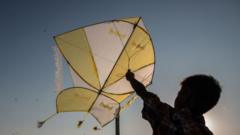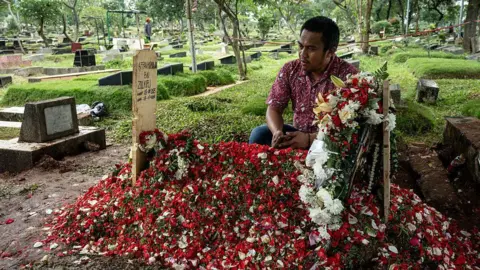At a paddy field just two kilometers from the bustling Soekarno-Hatta International Airport, the skies of Jakarta are alive with a colorful display of kites. The laughter and joy of children racing against the wind is frequently interrupted by the thunderous engines of departing and arriving planes overhead. Amidst the playful enthusiasm, however, looms the fear of airport officials ready to confiscate their beloved kites—a scenario familiar to the local youth.
Seven-year-old Atif expresses his newfound bravery, recounting how he now stands his ground when scolded by airport authorities. "If my kite is taken, it's sad, but I can always make another one," he states, symbolizing the resilience of tradition in the face of bureaucratic challenges.
Kite-flying is a treasured pastime in Indonesia, especially during school holidays, yet it faces scrutiny from airport officials who argue that unattended kites can hinder aircraft operations. In early July, kites caused significant disruptions at the airport, affecting 21 flights and even leading to aborted landings.
Putu Eka Cahyadi, the head of the Soekarno-Hatta Airport Authority, emphasizes the problem, describing kites as "moving obstacles" that pose "serious risks" to aviation safety. Such concerns are validated by past incidents, including a helicopter crash in Bali caused by kite strings and a previous emergency landing situation.
Despite the dangers highlighted by authorities, the love for kite-flying endures. Government officials, including transport minister Dudy Purwagandhi, have made efforts to divert youth towards alternative sports like football or badminton, yet the cultural significance of kite-flying is difficult to extinguish. Expert Asep Irawan describes how kites are an integral part of Indonesian heritage.
Regulations are strict; those caught flying dangerous items near airports can face severe penalties, including up to three years in prison. Yet tragically, the hazards extend beyond just aviation. A tragic incident last year saw an eight-year-old boy lose his life chasing a kite, underscoring the inherent dangers in urban settings.
As Jakarta grapples with rapid urbanization—losing 31% of its green spaces in two decades—children like 17-year-old Rasha find themselves with few places to fly. "There's nowhere else around here," he laments, highlighting the scarcity of safe areas for their cherished pastime.
The paddy field now serves as a hub for kite enthusiasts who host competitions and share their passion. Rasha himself has faced run-ins with authorities, leading to the confiscation and destruction of his kites, but his love for the activity remains unshaken. "Once your kites have been taken away, you stop being afraid," he comments—a testament to the bond between tradition and youthful defiance.
As the tug-of-war between safety and cultural practices continues, the vibrant skies of Jakarta remain a battleground for kites and planes, encapsulating the delicate balance between heritage and modernity.
Seven-year-old Atif expresses his newfound bravery, recounting how he now stands his ground when scolded by airport authorities. "If my kite is taken, it's sad, but I can always make another one," he states, symbolizing the resilience of tradition in the face of bureaucratic challenges.
Kite-flying is a treasured pastime in Indonesia, especially during school holidays, yet it faces scrutiny from airport officials who argue that unattended kites can hinder aircraft operations. In early July, kites caused significant disruptions at the airport, affecting 21 flights and even leading to aborted landings.
Putu Eka Cahyadi, the head of the Soekarno-Hatta Airport Authority, emphasizes the problem, describing kites as "moving obstacles" that pose "serious risks" to aviation safety. Such concerns are validated by past incidents, including a helicopter crash in Bali caused by kite strings and a previous emergency landing situation.
Despite the dangers highlighted by authorities, the love for kite-flying endures. Government officials, including transport minister Dudy Purwagandhi, have made efforts to divert youth towards alternative sports like football or badminton, yet the cultural significance of kite-flying is difficult to extinguish. Expert Asep Irawan describes how kites are an integral part of Indonesian heritage.
Regulations are strict; those caught flying dangerous items near airports can face severe penalties, including up to three years in prison. Yet tragically, the hazards extend beyond just aviation. A tragic incident last year saw an eight-year-old boy lose his life chasing a kite, underscoring the inherent dangers in urban settings.
As Jakarta grapples with rapid urbanization—losing 31% of its green spaces in two decades—children like 17-year-old Rasha find themselves with few places to fly. "There's nowhere else around here," he laments, highlighting the scarcity of safe areas for their cherished pastime.
The paddy field now serves as a hub for kite enthusiasts who host competitions and share their passion. Rasha himself has faced run-ins with authorities, leading to the confiscation and destruction of his kites, but his love for the activity remains unshaken. "Once your kites have been taken away, you stop being afraid," he comments—a testament to the bond between tradition and youthful defiance.
As the tug-of-war between safety and cultural practices continues, the vibrant skies of Jakarta remain a battleground for kites and planes, encapsulating the delicate balance between heritage and modernity.




















